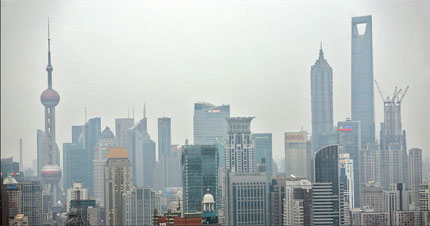Shanghai 'good air' days may be numbered
 0 Comment(s)
0 Comment(s) Print
Print E-mail Shanghai Daily, February 28, 2012
E-mail Shanghai Daily, February 28, 2012
Shanghai reported the most days with so-called excellent or good air quality in the past 12 years last year, but such a strong record is expected to drop 10 to 15 percent after the city introduces a more stringent measurement in June.
 |
|
Highrises from both Puxi and Pudong are seen during overcast weather yesterday in Shanghai. |
There were 337 days with excellent or good air quality last year, meaning 92.3 percent of all days made one of those grades, the best two of the five-tier category.
After enacting an action plan, the local pollutant index dropped 25.8 percent from 2000 and was 18.6 percent better than 2008. Decreased discharges of chemical oxygen demand, ammonia, sulfur dioxide and nitrogen oxide last year all surpassed the plan, but fine particles, ozone and sulfur-caused acid rain have become a major problem in the city, said the Shanghai Environmental Protection Bureau.
Officials said residents may not have felt the improvement in air quality, since the measuring system included only PM10, sulfur dioxide and nitrogen dioxide but not the stricter PM2.5 gauge, which monitors fine particles 2.5 microns or less in diameter.
PM2.5 affects air quality and visibility, causing haze, and posing major health risks as they are small enough to lodge deep in the lungs and even enter the bloodstream, leading to some premature deaths and long-term diseases.
Mayor Han Zheng said Shanghai has finished preparation and applied to the Ministry of Environmental Protection for being included the first batch of cities announcing the PM2.5 measurement to the public. That will happen later this year. PM2.5 is mainly caused by vehicle exhaust, flying dirt and industrial discharge, so the city will introduce tougher measures such as further eliminating vehicles with high pollution and carrying out tougher measures to control discharge of industrial plants.
Shanghai has failed to meet the proposed PM2.5 air quality standard for the past five years. Shanghai Environmental Monitoring Center data showed that the average density of PM2.5 was higher than a proposed PM2.5 standard every year since the pilot study began in 2005.
The watchdog's data was collected from 24 monitoring sites across the city. Yesterday the bureau also announced the fifth round of its three-year action plan on environmental protection starting this year. Air quality, water quality, noise control, industrial pollution control, agricultural pollution control and ecological protection are all key tasks of the new round.
In the new plan, 53 projects are targeting the control of air quality. Shanghai is likely to adopt the stricter National V emission standard, equivalent to European 5, on new cars next year, clean energy replacement on small and medium coal-burning boilers and power plant discharge control.






Go to Forum >>0 Comment(s)